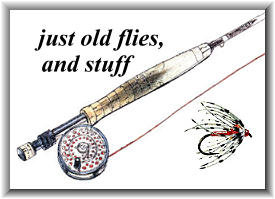This is one of a list of flies from William Blacker's book
Art of Fly Making, written in 1855. The fly
was unnamed, and is the #2 fly on the list. The entire group
of flies can also be found in Michael D. Radencich's book
Tying the Classic Salmon Fly, readily available
these days if you don't feel like spending a lot of time in
antiquarian book shops trying to find the Blacker.
This fly, as I've done it here, is a great example of
what can be done with substitutions. The style in which
I've tied it is quite different from the way Blacker would
have done it, and for that reason alone substitutes become
a necessity, not just a good idea. The more modern way of
tying these flies is to marry the wing together, but in
Blacker's day, disparate feather slips were tied on in
"clumps," rather crudely by today's standards. Yes, they
were "sorta kinda" married, but it took Kelson to improve
the married wing later so that it more resembled the wings
we do today. That's not to say that Blacker's wing wouldn't
have been effective when fished, they might have worked
better actually. In any case, marrying some of the components
listed in the wing for this fly is difficult indeed. Macaw
doesn't marry well at all, the strands being triangular in
shape, and summer duck is no bargain either, at least in a
main wing. So I've subbed in swan for the macaw and peacock
for the endangered and very pricey bustard.
Other substitutions are required here as well. The recipe
for puce dye was lost by Veniard many years ago, and I'm not
sure if anyone really knows what color puce is any more.
Blacker was also quite fond of morone colored silk, which
to me is a different shade of puce. Rather than agonize
over this, and there are those who do, I selected a darkish
purplish reddish brownish spool of old acetate floss that
I just happened to have on hand, and went with that. I
substituted seal for pig's wool, not wishing to shear a
pig, and used gold acetate floss in the tag instead of silk.
Seal and mohair are subbed for pig's wool by tiers these days,
more often than not. I like the look of seal personally, but
there are subs for THAT as well, Sealex, Pseudo Seal, and the
like. I might mention that I don't use them.
I've also subbed in blue dyed guinea for the jay. I've
actually have some jay, but it's always a bit short on any
fly 3/0 and larger, so I tend to go with the blue dyed guinea
a lot.
You may substitute as well for the gut on the fly, though I've
not done that here. Marvin Nolte has a nice article on how to
use ordinary tippet material as a gut sub here:
http://www.enersulspareparts.com/SALFLYER/vol_11/winter/gut_sub.htm
So there you have it, this fly is as bogus as a three-dollar
bill. I even went so far as to substitute Lady Amherst
pheasant tail for the silver pheasant tail, because I was
out of the silver pheasant. If you want to historically
accurate though, and like dying floss and shearing pigs,
here's the recipe for the real thing:
Blacker's #2 (unnamed)
Tag: Silver tinsel and gold silk.
Tail: A topping and summer duck.
Butt: Black herl.
Body: In equal parts of puce silk and orange pig's wool.
Ribs: Broad, flat silver tinsel.
Throat: Gallina rump followed by jay.
Wings: Mixed; golden pheasant tail, bustard, scarlet
macaw, summer duck, yellow macaw, silver pheasant tail,
mallard above, and a topping over all.
Horns: Blue and yellow macaw.
Head: Black herl.
Credits: Art of Fly Making by William Blacker;
Tying the Classic Salmon Fly by Michael D. Radencich. ~ EA
About Eric:
 I started fly fishing as a teen in and around my hometown
of Plattsburgh, New York, primarily on the Saranac River.
I started tying flies almost immediately and spent hours
with library books written by Ray Bergman, Art Lee, and
A. J. McClane. Almost from the beginning I liked tying
just as much as I liked fishing and spent considerable
time at the vise creating hideous monstrosities that
somehow caught fish anyway. Then one day I came upon a
group of flies that had been put out at a local drug store
that had been tied by Francis Betters of Wilmington, N.Y.
My life changed that day and so did my flies, dramatically.
Even though I never met Fran back then, I've always
considered him to be one of my biggest influences.
I started fly fishing as a teen in and around my hometown
of Plattsburgh, New York, primarily on the Saranac River.
I started tying flies almost immediately and spent hours
with library books written by Ray Bergman, Art Lee, and
A. J. McClane. Almost from the beginning I liked tying
just as much as I liked fishing and spent considerable
time at the vise creating hideous monstrosities that
somehow caught fish anyway. Then one day I came upon a
group of flies that had been put out at a local drug store
that had been tied by Francis Betters of Wilmington, N.Y.
My life changed that day and so did my flies, dramatically.
Even though I never met Fran back then, I've always
considered him to be one of my biggest influences.
I had a career in music for twenty years or so and didn't
fish much, though I did fish at times. The band I was with
had its fifteen seconds of fame when we were asked to be in
John Mellencamp's movie "Falling From Grace." I am the
keyboard player on the right in the country club scene in
the middle of the movie. Don't blink. It's on HBO all the
time. We got to meet big Hollywood stars and record in John's
studio. It was a blast.
So how did I wind up contributing to the Just Old Flies
column on FAOL? I'm not sure, it was something that I simply
wanted very badly to do, and they let me. Many of the old flies
take me back to the Adirondacs and my youth, and I guess I get
to relive some of it through the column. I've spent many happy
hours fishing and tying over the years, and tying these flies
brings back memories of great days on the water, and intense
hours spent looking at the flies in the fly plates in the old
books and trying to get my flies to look like them. And now,
here I am, still doing that to this day. ~ EA
|


 I started fly fishing as a teen in and around my hometown
of Plattsburgh, New York, primarily on the Saranac River.
I started tying flies almost immediately and spent hours
with library books written by Ray Bergman, Art Lee, and
A. J. McClane. Almost from the beginning I liked tying
just as much as I liked fishing and spent considerable
time at the vise creating hideous monstrosities that
somehow caught fish anyway. Then one day I came upon a
group of flies that had been put out at a local drug store
that had been tied by Francis Betters of Wilmington, N.Y.
My life changed that day and so did my flies, dramatically.
Even though I never met Fran back then, I've always
considered him to be one of my biggest influences.
I started fly fishing as a teen in and around my hometown
of Plattsburgh, New York, primarily on the Saranac River.
I started tying flies almost immediately and spent hours
with library books written by Ray Bergman, Art Lee, and
A. J. McClane. Almost from the beginning I liked tying
just as much as I liked fishing and spent considerable
time at the vise creating hideous monstrosities that
somehow caught fish anyway. Then one day I came upon a
group of flies that had been put out at a local drug store
that had been tied by Francis Betters of Wilmington, N.Y.
My life changed that day and so did my flies, dramatically.
Even though I never met Fran back then, I've always
considered him to be one of my biggest influences.